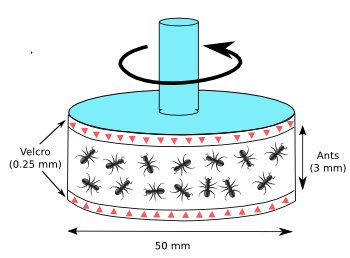
Viscoelastic Ants
December 17, 2015 In the days long before YouTube videos, my weekly dose of quality humor came from Monty Python's Flying Circus. Even today, snippets of this show, such as the The Lumberjack Song[1] and The Spanish Inquisition[2] are still popular. One catchphrase on Monty Python was "and now for something completely different." That describes the topic of this article, the mechanics of fire ants. Materials scientists often examine the mechanical properties of natural materials, such as wood and limestone, and occasionally they'll examine the natural products of animals, such as spider silk and nacre (mother of pearl). While mechanical testing on parts of animals, such as bone, is sometimes done, why would someone want to assess the mechanical properties of a whole living organism? Fire ants get their name from their sting, which injects an alkaloid venom, Solenopsin, that causes a sensation similar to being burned by fire. Just as for bee stings, the sting of the fire ant can kill sensitive people, and there are significant populations of these ants in fourteen US states.[3] Masses of fire ants will change shape in response to the environment. Fire ants will link their bodies to form self-assembled aggregations such as rafts to float in floods, and they will also link their bodies to build bridges across gaps. Just like a liquid, these aggregations can drip and spread, and they can also withstand applied loads. A physicist and mechanical engineers at the Georgia Institute of Technology (Atlanta, Georgia) decided to investigate the liquid-like and solid-like mechanical properties of fire ants, and their findings appear in Nature Materials.[4-6] | Fire ant (Solenopsis invicta) worker. This South American species established itself in the southeastern United States in the 1930s. (Specimen from Brackenridge Field Laboratory, Austin, Texas, via Wikimedia Commons.) |
 | Fire ant rheometer (Illustration by the author using Inkscape. Ant image via Wikimedia Commons.) |
"It's not unlike ketchup... The harder you squeeze, the easier it flows. But with ants, this happens much more dramatically than with ketchup."[6]
 | Ants in a rheometer. At high shear rates, the ants "play dead," an action that decreases the viscosity of the mass. (Georgia Tech image.) |
"Ants seem to have an on/off switch in that they let go for sufficiently large applied forces... Despite wanting to be together, they let go and behave like a fluid to prevent getting injured or killed."[6]A similar phenomenon is seen when an object, such as a penny, is dropped into a pile of ants. In that case, ants will flow around the coin as it sinks, and the sinking takes a considerable time to happen. When such a pile is poked quickly, the mechanical response is like that of a spring, and the pile quickly returns to its original shape.[6] Such a mechanical behavior is known as viscoelasticity, and the rheometer measurements also show viscoelastic behavior.[4]
 | If a penny is dropped into a pile of ants, the insects release their hold on each other in response to the pressure. When the coin passes through, the ants reconnect. (Georgia Tech image.) |
"If you cut a dinner roll with a knife, you're going to end up with two pieces of bread... But if you cut through a pile of ants, they'll simply let the knife go through, then reform on the other side. They're like liquid metal - just like that scene in the Terminator movie."[6]This research is supported by the U.S. Army Research Laboratory and the U.S. Army Research Office Mechanical Sciences Division, Complex Dynamics and Systems Program.[6]
References:
- Monty Python's Lumberjack song, YouTube Video, January 19, 2006. A German language version can be found here (Lumberjack-Song in German, YouTube Video, August 4, 2006).
- Monty Python's Flying Circus - Complete Spanish Inquisition, YouTube Video, January 18, 2009.
- "States affected by: Imported Fire Ant," USDA, Animal and Plant Health Inspection Service.
- Michael Tennenbaum, Zhongyang Liu, David Hu, and Alberto Fernandez-Nieves, "Mechanics of fire ant aggregations," Nature Materials, October 26, 2015, doi:10.1038/nmat4450.
- Supplementary Information for ref. 4 (PDF File).
- Ants: Both Solid-like and Liquid-like - Ants act like ketchup when forces applied, Georgia Institute of Technology Press Release, October 26, 2015.
- Mcgregor Rob Roy and Warrick Earl Leathen, "Treating dimethyl silicone polymer with boric oxide," US Patent No. 2,431,878, December 2, 1947.
- James G E Wright, "Process for making puttylike elastic plastic, siloxane derivative composition containing zinc hydroxide," US Patent No. 2,541,851, Feb 13, 1951.
- Additional fire ant images and videos, via Dropbox.